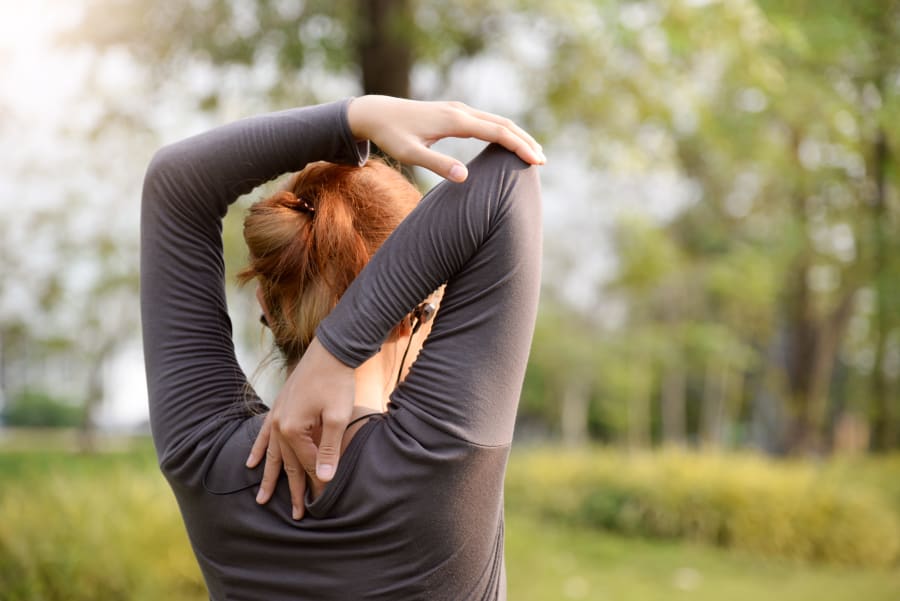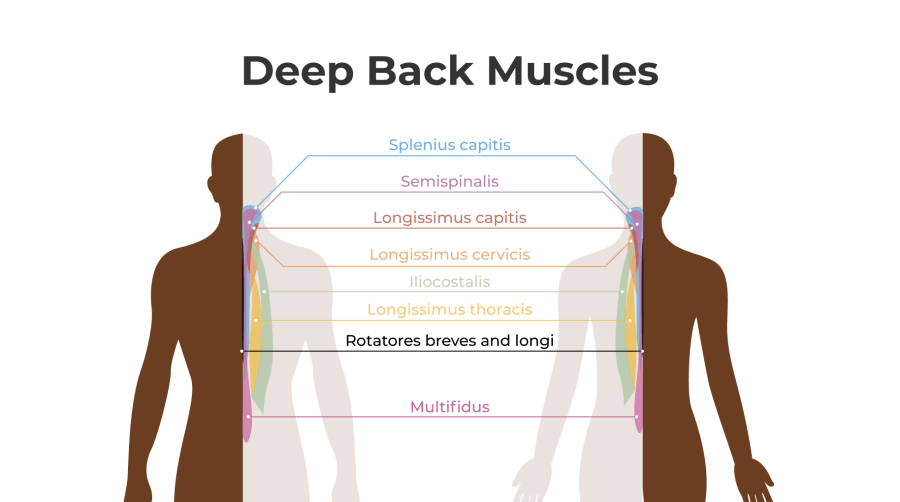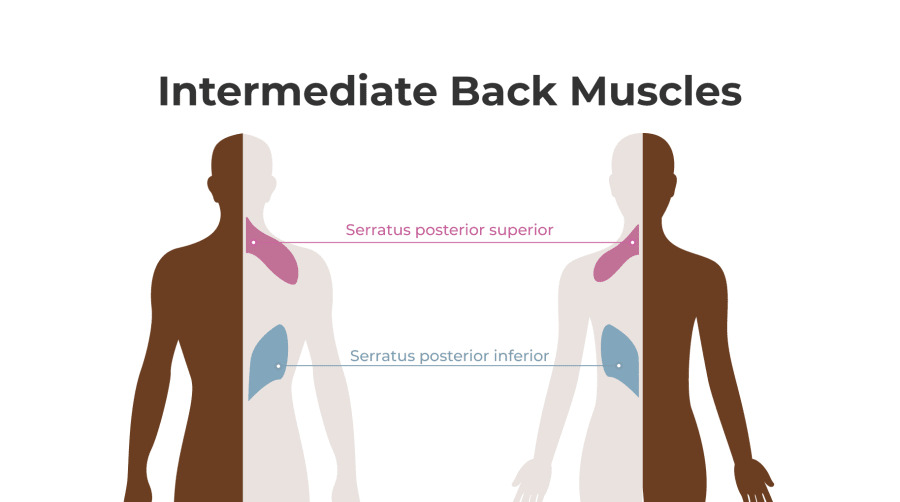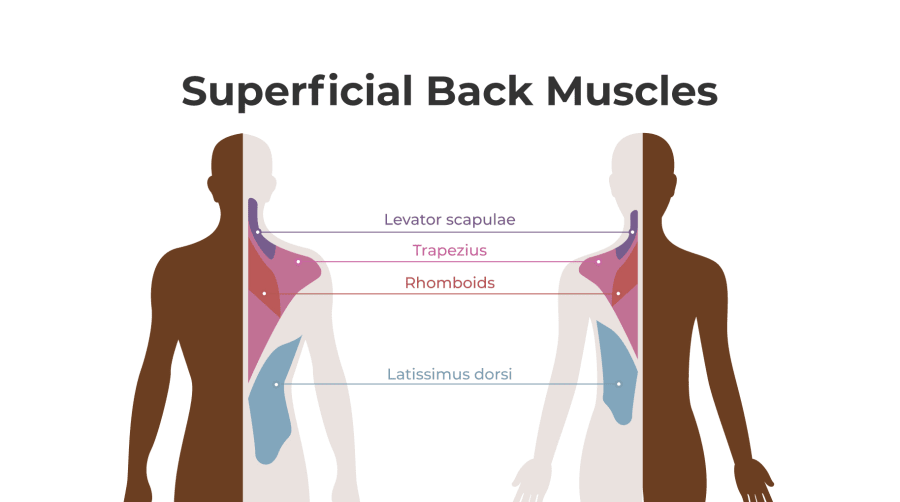Muscles of the Upper Back
Max Frenkel

Understanding your upper back muscles is the key to fixing back pain and improving posture. Your upper back contains several important muscle groups that control movement, support your spine, and maintain proper alignment throughout the day.
Quick Guide: The upper back has three main muscle layers – superficial (trapezius, latissimus dorsi), intermediate (rhomboids, levator scapulae), and deep muscles. Poor posture weakens these muscles, causing pain and dysfunction.
Back pain can be annoying and limiting. It can be chronic or sudden and can be caused by long-term conditions or one-time injuries. By understanding how your upper back muscles work, you can identify the cause and potentially reduce your pain.
Your back is made up of muscles that help you turn, lean, sit, and stand. They even help your posture! Unfortunately, these muscles can often cause pain when damaged, strained, stretched, or overused. Pain can also occur related to a non-back-related condition. Learn about the muscles that make up your back and what might be causing you back pain.
What Are the Upper Back Muscles Called?
The upper back contains numerous muscles organized in three distinct layers, each with specific functions for movement and posture support. Understanding these muscle groups helps you identify pain sources and choose appropriate treatments.
Deep Upper Back Muscles

Deep muscles are the innermost layer, located closest to your spine and vertebrae. These muscles are primarily responsible for:
- Spinal stability: Maintaining proper vertebral alignment
- Fine motor control: Precise movements of individual vertebrae
- Postural support: Keeping your spine in neutral position
If you’re experiencing deep muscle pain, it’s often from strain caused by poor posture or sudden movements. These muscles work constantly to support your spine, making them vulnerable to overuse.
Intermediate Upper Back Muscles

Intermediate muscles are located between the deep and superficial layers and primarily control:
- Rib cage movement: Essential for breathing and trunk rotation
- Thoracic stability: Supporting the middle portion of your spine
- Postural endurance: Maintaining upright position during long activities
A sprain, strain, or overuse of intermediate muscles may be the culprit of your back pain, especially if you experience discomfort during breathing or trunk rotation.
Superficial Upper Back Muscles (Most Important for Posture)

Superficial muscles are the outermost layer and the most important for daily posture and movement. These include the major muscles most people recognize:
1. Trapezius Muscle
The trapezius is a large, trapezoid-shaped muscle that extends from your neck to your mid-back. It’s divided into three parts:
- Upper trapezius: Elevates and supports your shoulders
- Middle trapezius: Retracts your shoulder blades
- Lower trapezius: Depresses and stabilizes your shoulder blades
Common problems: The trapezius is easily strained from poor posture, especially “forward head posture” from computer work. When strained, turning and tilting your head becomes difficult and painful.
2. Latissimus Dorsi
The latissimus dorsi is the largest muscle of the upper body, controlling much of your upper body’s movement. Key functions include:
- Arm movement: Pulling your arms toward your body
- Trunk stability: Supporting your torso during movement
- Posture support: Maintaining upright positioning
Common problems: Latissimus dorsi strain can cause “frozen shoulder” syndrome where the shoulder becomes stiff and difficult to move. This muscle is frequently overused in activities like swimming, climbing, or repetitive reaching.
3. Levator Scapulae
The levator scapulae muscle connects your neck to your shoulder blade and functions to:
- Neck stability: Holding your neck in proper alignment
- Shoulder blade control: Elevating and rotating the scapula
Common problems: If your neck or upper back hurt, poor posture resulting in levator scapulae pain or tightness is often the cause. This muscle becomes chronically tight in people with forward head posture.
4. Rhomboids
The rhomboid muscles (major and minor) are crucial for:
- Posture control: Retracting and stabilizing shoulder blades
- Scapular movement: Controlling shoulder blade positioning
Common problems: Rhomboid pain can be caused by muscle strain, but since these muscles are near critical nerves, pain is often from nerve compression. This causes characteristic muscle spasms in the area between your shoulder blades.
Common Upper Back Muscle Problems and Causes
Once you understand which muscles might be causing your discomfort, you can better address the underlying causes. Upper back muscle pain typically falls into several categories:
Postural Muscle Imbalances
The most common cause of upper back muscle problems is postural dysfunction, particularly:
- Forward head posture: Overworks upper trapezius and levator scapulae
- Rounded shoulders: Weakens rhomboids and middle trapezius
- Slouched sitting: Creates imbalances throughout the upper back
Solution: Improving posture is the most effective way to prevent and treat upper back muscle problems. Smart posture trainers like the UPRIGHT GO 2 provide real-time feedback to retrain these muscles and restore proper alignment.
Acute Muscle Strains
Sudden injuries to upper back muscles can occur from:
- Lifting heavy objects: Especially with poor form
- Sudden movements: Quick twisting or reaching motions
- Sports activities: Swimming, tennis, golf, or weightlifting
Chronic Overuse Conditions
Repetitive activities that overwork upper back muscles include:
- Computer work: Hours of poor posture and repetitive arm movements
- Manual labor: Repetitive lifting, reaching, or carrying
- Poor sleep position: Inadequate pillow or mattress support
Medical Conditions Affecting Upper Back Muscles
Sometimes upper back muscle pain stems from underlying medical conditions rather than mechanical issues:
- Osteoarthritis: Joint degeneration affecting spinal movement
- Spinal infections: Bacterial or viral infections affecting vertebrae
- Myofascial pain syndrome: Chronic muscle pain with trigger points
- Scoliosis: Spinal curvature causing muscle imbalances
- Fibromyalgia: Widespread muscle pain and sensitivity
Important: While muscle strain is the most common cause of upper back pain, certain symptoms warrant immediate medical attention, including severe pain, numbness, weakness, or pain that radiates to other areas.
How to Strengthen and Protect Your Upper Back Muscles
Prevention is always better than treatment when it comes to upper back muscle health. Here are the most effective strategies:
1. Improve Your Posture
Proper posture is the foundation of healthy upper back muscles. Key elements include:
- Head alignment: Ears directly over shoulders
- Shoulder position: Relaxed and slightly pulled back
- Spine alignment: Maintaining natural curves
The UPRIGHT GO 2 posture trainer helps you maintain these positions throughout the day by providing gentle vibration feedback when you slouch, training your muscles to hold proper alignment naturally.
2. Targeted Strengthening Exercises
Specific exercises for each muscle group:
For Trapezius:
- Shoulder blade squeezes
- Wall push-ups
- Resistance band pulls
For Rhomboids:
- Reverse flyes
- Seated cable rows
- Face pulls
For Latissimus Dorsi:
- Lat pulldowns
- Pull-ups (assisted if needed)
- Single-arm dumbbell rows
3. Daily Stretching Routine
Maintain muscle flexibility with these stretches:
- Upper trap stretch: Gently pull head to side
- Doorway chest stretch: Open tight chest muscles
- Cat-cow stretches: Mobilize entire spine
- Shoulder blade squeezes: Activate rhomboids and middle traps
4. Ergonomic Workspace Setup
Create a muscle-friendly work environment:
- Monitor height: Top of screen at eye level
- Keyboard position: Elbows at 90 degrees
- Chair support: Lumbar support and armrests
- Regular breaks: Stand and move every 30 minutes
When to Seek Professional Help
While many upper back muscle issues resolve with proper self-care, certain symptoms require professional evaluation:
- Severe pain: Pain that interferes with daily activities
- Persistent symptoms: Pain lasting more than a few days without improvement
- Neurological symptoms: Numbness, tingling, or weakness
- Radiating pain: Pain spreading to arms, chest, or other areas
- Fever or illness: Systemic symptoms accompanying back pain
A licensed healthcare professional can provide accurate diagnosis and create a comprehensive treatment plan tailored to your specific condition.
Frequently Asked Questions About Upper Back Muscles
What is the largest upper back muscle?
The latissimus dorsi is the largest muscle in the upper body. It spans from your lower back to your upper arm and is responsible for many pulling movements and trunk stability.
Which upper back muscles are most important for posture?
The rhomboids, middle trapezius, and deep spinal muscles are most critical for maintaining good posture. These muscles work together to keep your shoulder blades back and your spine aligned.
Why do my upper back muscles hurt from sitting?
Prolonged sitting, especially with poor posture, causes muscle imbalances. Your upper back muscles become overstretched and weak while chest muscles tighten, leading to pain and dysfunction.
How can I tell if I have a muscle strain or something more serious?
Muscle strains typically cause localized pain that worsens with movement but improves with rest. Seek medical attention if you experience severe pain, numbness, tingling, weakness, or pain that radiates to other areas.
Can poor posture permanently damage upper back muscles?
While poor posture can cause chronic muscle imbalances and pain, the damage is usually reversible with proper intervention. Consistent posture training, exercises, and ergonomic improvements can restore muscle function and eliminate pain.
Take Action for Healthier Upper Back Muscles
Understanding your upper back muscles is the first step toward eliminating pain and improving your overall posture and health. These complex muscle groups work together to support your spine, control movement, and maintain proper alignment throughout your daily activities.
By implementing proper posture habits, targeted exercises, and ergonomic improvements, you can protect these vital muscles from strain and overuse. For those serious about long-term muscle health and posture improvement, consider using a smart posture trainer to provide constant feedback and accelerate your progress.
Ready to transform your upper back health? The UPRIGHT GO 2 trains your upper back muscles naturally through real-time biofeedback, helping you develop the strength and alignment needed for pain-free living.
You Might also Like
Search
Sign up to our newsletter
Follow Us On
Popular
Revisit the GO 2/S Device Setup
How to get started
Finding your upright position
How to find your target upright posture
Calibration
Check out the UPRIGHT GO 2

